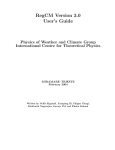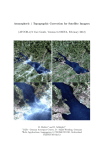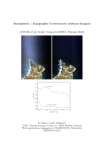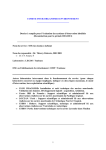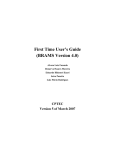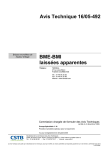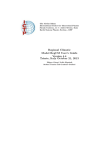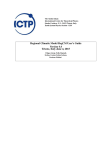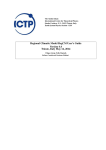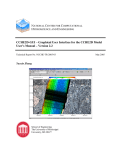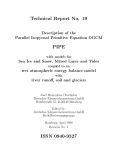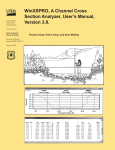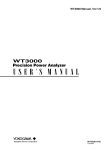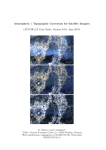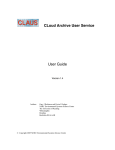Download RegCM Version 3.1 User's Guide
Transcript
RegCM Version 3.1 User’s Guide Nellie Elguindi, Xunqiang Bi, Filippo Giorgi, Badrinath Nagarajan, Jeremy Pal, Fabien Solmon, Sara Rauscher, and Ashraf Zakey Trieste, Italy July 2007 1 Abstract As one of the main aims of the Abdus Salam International Centre for Theoretical Physics (ICTP) is to foster the growth of advanced studies and research in developing countries, the main purpose of this Regional Climate Model (REGional Climate Model (RegCM)) Tutorial Class Notes is to give model users a guide to learn the whole RegCM Model System. The RegCM Tutorial Class is offered as a part of extended hands-on lab sessions during a series of Workshops organized by the Physics of Weather and Climate (PWC) group at the ICTP. RegCM was originally developed at the National Center for Atmospheric Research (NCAR) and has been mostly applied to studies of regional climate and seasonal predictability around the world. The workshop participants are welcome to use RegCM for regional climate simulation over different areas of interest. The RegCM is available on the World Wide Web at http://www.ictp.trieste.it/∼pubregcm/RegCM3. 2 Contents 1 2 3 4 Introduction 6 1.1 History . . . . . . . . . . . . . . . . . . . . . . . . . . . . . . . . . . . . . . . . . . . . . . . . 6 1.2 The RegCM Model Horizontal and Vertical Grid . . . . . . . . . . . . . . . . . . . . . . . . . . 8 1.3 Map Projections and Map-Scale Factors . . . . . . . . . . . . . . . . . . . . . . . . . . . . . . . 11 Model Description 12 2.1 Dynamics . . . . . . . . . . . . . . . . . . . . . . . . . . . . . . . . . . . . . . . . . . . . . . . 12 2.2 Physics . . . . . . . . . . . . . . . . . . . . . . . . . . . . . . . . . . . . . . . . . . . . . . . . 16 2.2.1 Radiation Scheme . . . . . . . . . . . . . . . . . . . . . . . . . . . . . . . . . . . . . . 16 2.2.2 Land Surface Model . . . . . . . . . . . . . . . . . . . . . . . . . . . . . . . . . . . . . 16 2.2.3 Planetary Boundary Layer Scheme . . . . . . . . . . . . . . . . . . . . . . . . . . . . . . 17 2.2.4 Convective Precipitation Schemes . . . . . . . . . . . . . . . . . . . . . . . . . . . . . . 18 2.2.5 Large-Scale Precipitation Scheme . . . . . . . . . . . . . . . . . . . . . . . . . . . . . . 21 2.2.6 Ocean flux Parameterization . . . . . . . . . . . . . . . . . . . . . . . . . . . . . . . . . 23 2.2.7 Pressure Gradient Scheme . . . . . . . . . . . . . . . . . . . . . . . . . . . . . . . . . . 24 2.2.8 Lake Model . . . . . . . . . . . . . . . . . . . . . . . . . . . . . . . . . . . . . . . . . . 24 2.2.9 Aerosols and Dust (Chemistry Model) . . . . . . . . . . . . . . . . . . . . . . . . . . . . 25 Pre-Processing 26 3.1 Terrain . . . . . . . . . . . . . . . . . . . . . . . . . . . . . . . . . . . . . . . . . . . . . . . . . 26 3.2 ICBC . . . . . . . . . . . . . . . . . . . . . . . . . . . . . . . . . . . . . . . . . . . . . . . . . 29 3.2.1 Sea surface temperature . . . . . . . . . . . . . . . . . . . . . . . . . . . . . . . . . . . 30 3.2.2 Data for Initial and Lateral Boundary Conditions . . . . . . . . . . . . . . . . . . . . . . 30 3.2.3 Lateral Boundary Treatment . . . . . . . . . . . . . . . . . . . . . . . . . . . . . . . . . 31 3.2.4 Running ICBC . . . . . . . . . . . . . . . . . . . . . . . . . . . . . . . . . . . . . . . . 31 RegCM 34 4.1 34 Selecting the appropriate time steps . . . . . . . . . . . . . . . . . . . . . . . . . . . . . . . . . 3 5 4.2 Starting the simulation . . . . . . . . . . . . . . . . . . . . . . . . . . . . . . . . . . . . . . . . 36 4.3 Restarting a simulation . . . . . . . . . . . . . . . . . . . . . . . . . . . . . . . . . . . . . . . . 36 Post-processing 37 5.0.1 Converting sigma-level data to pressure levels . . . . . . . . . . . . . . . . . . . . . . . . 37 Observational Data Interpolator . . . . . . . . . . . . . . . . . . . . . . . . . . . . . . . . . . . . 38 5.1 6 Practice Run 41 6.1 Getting the model code and data . . . . . . . . . . . . . . . . . . . . . . . . . . . . . . . . . . . 41 6.2 Pre-processing . . . . . . . . . . . . . . . . . . . . . . . . . . . . . . . . . . . . . . . . . . . . . 42 6.2.1 Setting up the domain . . . . . . . . . . . . . . . . . . . . . . . . . . . . . . . . . . . . 42 6.2.2 ICBC . . . . . . . . . . . . . . . . . . . . . . . . . . . . . . . . . . . . . . . . . . . . . 44 Running the Model . . . . . . . . . . . . . . . . . . . . . . . . . . . . . . . . . . . . . . . . . . 45 6.3.1 Restarting the model . . . . . . . . . . . . . . . . . . . . . . . . . . . . . . . . . . . . . 47 Post-processing . . . . . . . . . . . . . . . . . . . . . . . . . . . . . . . . . . . . . . . . . . . . 48 6.4.1 49 6.3 6.4 Interpolating observational data to your RegCM grid . . . . . . . . . . . . . . . . . . . . 4 List of Figures 1 Schematic representation of the vertical structure of the model. This example is for 16 vertical layers. Dashed lines denote half-sigma levels, solid lines denote full-sigma levels. (Adapted from the PSU/NCAR Mesoscale Modeling System Tutorial Class Notes and User’s Guide.) . . . . . . . 2 9 Schematic representation showing the horizontal Arakawa B-grid staggering of the dot and cross grid points. . . . . . . . . . . . . . . . . . . . . . . . . . . . . . . . . . . . . . . . . . . . . . . 10 List of Tables 1 Land Cover/Vegetation classes . . . . . . . . . . . . . . . . . . . . . . . . . . . . . . . . . . . . 27 2 BATS vegetation/land-cover . . . . . . . . . . . . . . . . . . . . . . . . . . . . . . . . . . . . . 28 3 List of variables defined in domain.param file. . . . . . . . . . . . . . . . . . . . . . . . . . . . . 32 4 List of output variables from Terrain (DOMAIN) . . . . . . . . . . . . . . . . . . . . . . . . . . 33 5 List of variables in ICBCYYYYMMDDHH files . . . . . . . . . . . . . . . . . . . . . . . . . . . 33 6 List of restart, timestep, and output parameters defined in regcm.in file. . . . . . . . . . . . . . . . 34 7 List of physic options in regcm.in file. . . . . . . . . . . . . . . . . . . . . . . . . . . . . . . . . 35 8 List of output variables from atmosphere . . . . . . . . . . . . . . . . . . . . . . . . . . . . . . . 39 9 List of output variables from surface model . . . . . . . . . . . . . . . . . . . . . . . . . . . . . 39 10 List of output variables from radiation model . . . . . . . . . . . . . . . . . . . . . . . . . . . . 40 11 List of output variables from tracer model . . . . . . . . . . . . . . . . . . . . . . . . . . . . . . 40 12 Time steps with different resolutions . . . . . . . . . . . . . . . . . . . . . . . . . . . . . . . . . 40 13 List of variables to be modified in domain.param file. . . . . . . . . . . . . . . . . . . . . . . . . 42 14 List of variables to be modified in regcm.in file. . . . . . . . . . . . . . . . . . . . . . . . . . . . 45 5 1 Introduction 1.1 History The idea that limited area models (LAMs) could be used for regional studies was originally proposed by Dickinson et al. (1989) and Giorgi (1990). This idea was based on the concept of one-way nesting, in which large scale meteorological fields from General Circulation Model (GCM) runs provide initial and timedependent meteorological lateral boundary conditions (LBCs) for high resolution Regional Climate Model (RCM) simulations, with no feedback from the RCM to the driving GCM. The first generation NCAR RegCM was built upon the NCAR-Pennsylvania State University (PSU) Mesoscale Model version 4 (MM4) in the late 1980s (Dickinson et al., 1989; Giorgi, 1989). The dynamical component of the model originated from the MM4, which is a compressible, finite difference model with hydrostatic balance and vertical σ-coordinates. Later, the use of a split-explicit time integration scheme was added along with an algorithm for reducing horizontal diffusion in the presence of steep topographical gradients (Giorgi et al., 1993a,b). As a result, the dynamical core of the RegCM is similar to that of the hydrostatic version of Mesoscale Model version 5 (MM5) (Grell et al., 1994). For application of the MM4 to climate studies, a number of physics parameterizations were replaced, mostly in the areas of radiative transfer and land surface physics, which led to the first generation RegCM (Dickinson et al., 1989; Giorgi, 1990). The first generation RegCM included the Biosphere-Atmosphere Transfer Scheme, BATS, (Dickinson et al., 1986) for surface process representation, the radiative transfer scheme of the Community Climate Model version 1 (CCM1), a medium resolution local planetary boundary layer scheme, the Kuo-type cumulus convection scheme of (Anthes, 1977) and the explicit moisture scheme of (Hsie et al., 1984). A first major upgrade of the model physics and numerical schemes was documented by (Giorgi et al., 1993a,b), and resulted in a second generation RegCM, hereafter referred to as REGional Climate Model version 2 (RegCM2). The physics of RegCM2 was based on that of the NCAR Community Climate Model version 2 (CCM2) (Hack et al., 1993), and the mesoscale model MM5 (Grell et al., 1994). In particular, the CCM2 radiative transfer package (Briegleb, 1992) was used for radiation calculations, the non local boundary layer scheme of (Holtslag et al., 1990) replaced the older local scheme, the mass flux cumulus cloud scheme of (Grell, 1993) was added as an option, and the latest version of BATS1E (Dickinson et al., 1993) was included in the model. 6 In the last few years, some new physics schemes have become available for use in the RegCM, mostly based on physics schemes of the latest version of the Community Climate Model (CCM), Community Climate Model version 3 (CCM3) (Kiehl et al., 1996). First, the CCM2 radiative transfer package has been replaced by that of the CCM3. In the CCM2 package, the effects of H2 O, O3 , O2 , CO2 and clouds were accounted for by the model. Solar radiative transfer was treated with a δ-Eddington approach and cloud radiation depended on three cloud parameters, the cloud fractional cover, the cloud liquid water content, and the cloud effective droplet radius. The CCM3 scheme retains the same structure as that of the CCM2, but it includes new features such as the effect of additional greenhouse gases (NO2 , CH4 , CFCs), atmospheric aerosols, and cloud ice. The other primary changes are in the areas of cloud and precipitation processes. The original explicit moisture scheme of Hsie et al. (1984) has been substituted with a simplified version because the original scheme was computationally too expensive to be run in climate mode. In the simplified scheme only a prognostic equation for cloud water is included, which accounts for cloud water formation, advection and mixing by turbulence, reevaporation in sub-saturated conditions, and conversion into rain via a bulk autoconversion term. The main novelty of this scheme does not reside of course in the simplistic microphysics, but in the fact that the prognosed cloud water variable is directly used in the cloud radiation calculations. In the previous versions of the model, cloud water variables for radiation calculations were diagnosed in terms of the local relative humidity. This new feature adds a very important and far reaching element of interaction between the simulated hydrologic cycle and energy budget calculations. Changes in the model physics include a large-scale cloud and precipitation scheme which accounts for the subgrid-scale variability of clouds (?), new parameterizations for ocean surface fluxes (Zeng et al., 1998), and a cumulus convection scheme (Emanuel, 1991; Emanuel and Zivkovic-Rothman, 1999). Also new in the model is a mosaic-type parameterization of subgrid-scale heterogeneity in topography and land use (Giorgi et al., 2003b). Other improvements in RegCM3 involve the input data. The USGS Global Land Cover Characterization and Global 30 Arc-Second Elevation datasets are now used to create the terrain files. In addition, NCEP and ECMWF global reanalysis datasets are used for the intial and boundary conditions. Lastly, improvements in the userfriendliness of the model have been made. New scripts have been included which make running the programs easier. Also, a new website has been developed where users can freely download the entire RegCM system, as well as all of the input data necessary for a simulation. 7 The RegCM modeling system has four components: Terrain, ICBC, RegCM, and Postprocessor. Terrain and ICBC are the two components of RegCM preprocessor. Terrestrial variables (including elevation, landuse and sea surface temperature) and three-dimensional isobaric meteorological data are horizontally interpolated from a latitude-longitude mesh to a high-resolution domain on either a Rotated (and Normal) Mercator, Lambert Conformal, or Polar Stereographic projection. Vertical interpolation from pressure levels to the σ coordinate system of RegCM is also performed. σ surfaces near the ground closely follow the terrain, and the higher-level σ surfaces tend to approximate isobaric surfaces. Since the vertical and horizontal resolution and domain size can vary, the modeling package programs employ parameterized dimensions requiring a variable amount of core memory, and the requisite hard-disk storage amount is varied accordingly. 1.2 The RegCM Model Horizontal and Vertical Grid It is useful to first introduce the model’s grid configuration. The modeling system usually gets and analyzes its data on pressure surfaces, but these have to be interpolated to the model’s vertical coordinate before input to the model. The vertical coordinate is terrain-following (Figure 1) meaning that the lower grid levels follow the terrain while the upper surface is flatter. Intermediate levels progressively flatten as the pressure decreases toward the top of the model. A dimensionless σ coordinate is used to define the model levels where p is the pressure, pt is a specified constant top pressure, ps is the surface pressure. σ= (p − pt ) (ps − pt ) (1) It can be seen from the equation and Figure 1 that σ is zero at the top and one at the surface, and each model level is defined by a value of σ. The model vertical resolution is defined by a list of values between zero and one that do not necessarily have to be evenly spaced. Commonly the resolution in the boundary layer is much finer than above, and the number of levels may vary upon the user demand. The horizontal grid has an Arakawa-Lamb B-staggering of the velocity variables with respect to the scalar variables. This is shown in Figure 2 where it can be seen that the scalars (T, q, p, etc) are defined at the center of the grid box, while the eastward (u) and northward (v) velocity components are collocated at the corners. The center 8 Figure 1: Schematic representation of the vertical structure of the model. This example is for 16 vertical layers. Dashed lines denote half-sigma levels, solid lines denote full-sigma levels. (Adapted from the PSU/NCAR Mesoscale Modeling System Tutorial Class Notes and User’s Guide.) 9 Figure 2: Schematic representation showing the horizontal Arakawa B-grid staggering of the dot and cross grid points. 10 points of grid squares will be referred to as cross points, and the corner points are dot points. Hence horizontal velocity is defined at dot points. Data is input to the model, the preprocessors do the necessary interpolation to assure consistency with the grid. All the above variables are defined in the middle of each model vertical layer, referred to as half-levels and represented by the dashed lines in Figure 1. Vertical velocity is carried at the full levels (solid lines). In defining the sigma levels it is the full levels that are listed, including levels at σ = 0 and 1. The number of model layers is therefore always one less than the number of full sigma levels. The finite differencing in the model is, of course, crucially dependent upon the grid staggering wherever gradients or averaging are represented terms in the equation. 1.3 Map Projections and Map-Scale Factors The modeling system has a choice of four map projections. Lambert Conformal is suitable for mid-latitudes, Polar Stereographic for high latitudes, Normal Mercator for low latitudes, and Rotated Mercator for extra choice. The x and y directions in the model do not correspond to west-east and north-south except for the Normal Mercator projection, and therefore the observed wind generally has to be rotated to the model grid, and the model u and v components need to be rotated before comparison with observations. These transformations are accounted for in the model pre-processors that provide data on the model grid, and in the post-processors. The map scale factor, m, is defined by m = (distance on grid) / (actual distance on earth) and its value is usually close to one, varying with latitude. The projections in the model preserve the shape of small areas, so that dx=dy everywhere, but the grid length varies across the domain to allow a representation of a spherical surface on a plane surface. Map-scale factors need to be accounted for in the model equations wherever horizontal gradients are used. 11 2 Model Description 2.1 Dynamics The model dynamic equations and numerical discretization are described by Grell et al. (1994). Horizontal Momentum Equations ∂p∗ u = −m2 ∂t ∂p∗ uσ˙ ∂p∗ uu/m ∂p∗ vu/m − + ∂x ∂y ∂σ −mp∗ ∂p∗ v = −m2 ∂t ∂p∗ ∂φ RTv + f p∗ v + FH u + FV u, + (p∗ + pt /σ) ∂x ∂x (2) ∂p∗ vσ˙ ∂p∗ uv/m ∂p∗ vv/m − + ∂x ∂y ∂σ −mp∗ ∂p∗ ∂φ RTv + f p∗ u + FH v + FV v, + (p∗ + pt /σ) ∂y ∂y (3) where u and v are the eastward and northward components of velocity, Tv is virtual temperature, φ is geopotential height, f is the coriolis parameter, R is the gas constant for dry air, m is the map scale factor for either the Polar Stereographic, Lambert Conformal, or Mercator map projections, σ˙ = dσ dt , and FH and FV represent the effects of horizontal and vertical diffusion, and p∗ = ps − pt . ˙ Equations Continuity and Sigmadot (σ) ∂p∗ = −m2 ∂t ∂p∗ σ˙ ∂p∗ u/m ∂p∗ v/m − + . ∂x ∂y ∂σ (4) The vertical integral of Equation 4 is used to compute the temporal variation of the surface pressure in the model, 12 ∂p∗ = −m2 ∂t Z 1 ∗ ∂p u/m ∂x 0 After calculation of the surface-pressure tendency ∂p∗ ∂t , ∂p∗ v/m dσ. + ∂y (5) ˙ is computed the vertical velocity in sigma coordinates (σ) at each level in the model from the vertical integral of Equation 4. σ˙ = − 1 p∗ Z σ ∗ ∂p 0 ∂t +m 2 ∂p∗ u/m ∂p∗ v/m + ∂x ∂y ˙ = 0) = 0. where σ′ is a dummy variable of integration and σ(σ 13 dσ′, (6) Thermodynamic Equation and Equation for Omega (ω) The thermodynamic equation is ∂p∗ T = −m2 ∂t ∂p∗ T σ˙ ∂p∗ uT /m ∂p∗ vT /m − + + ∂x ∂y ∂σ p∗ Q RTv ω + FH T + FV T, + c pm (σ + Pt /past ) c pm (7) where c pm is the specific heat for moist air at constant pressure, Q is the diabatic heating, FH T represents the effect of horizontal diffusion, FV T represents the effect of vertical mixing and dry convective adjustment, and ω is ω = p∗ σ˙ + σ d p∗ , dt (8) where, ∂p∗ ∂p∗ ∂p∗ d p∗ . = +m u +v dt ∂t ∂x ∂y The expression for c pm = c p (1 + 0.8qv), where c p is the specific heat at constant pressure for dry air and qv is the mixing ratio of water vapor. Hydrostatic Equation The hydrostatic equation is used to compute the geopotential heights from the virtual temperature Tv , 14 (9) ∂φ qc + qr −1 , = −RTv 1 + ∂ln(σ + pt /p∗ ) 1 + qv (10) where Tv = T (1 + 0.608qv), qv , qc , and qr are the water vapor, cloud water or ice, and rain water or snow, mixing ratios. 15 2.2 Physics 2.2.1 Radiation Scheme RegCM3 uses the radiation scheme of the NCAR CCM3, which is described in Kiehl et al. (1996). Briefly, the solar component, which accounts for the effect of O3 , H2 O, CO2 , and O2 , follows the δ-Eddington approximation of Kiehl et al. (1996). It includes 18 spectral intervals from 0.2 to 5 µm. The cloud scattering and absorption parameterization follow that of Slingo (1989), whereby the optical properties of the cloud droplets (extinction optical depth, single scattering albedo, and asymmetry parameter) are expressed in terms of the cloud liquid water content and an effective droplet radius. When cumulus clouds are formed, the gridpoint fractional cloud cover is such that the total cover for the column extending from the model-computed cloud-base level to the cloud-top level (calculated assuming random overlap) is a function of horizontal gridpoint spacing. The thickness of the cloud layer is assumed to be equal to that of the model layer, and a different cloud water content is specified for middle and low clouds. 2.2.2 Land Surface Model The surface physics are performed using Biosphere-Atmosphere Transfer Scheme version 1e (BATS1e) which is described in detail by Dickinson et al. (1993). BATS is a surface package designed to describe the role of vegetation and interactive soil moisture in modifying the surface-atmosphere exchanges of momentum, energy, and water vapor. The model has a vegetation layer, a snow layer, a surface soil layer, 10 cm thick, or root zone layer, 1-2 m thick, and a third deep soil layer 3 m thick. Prognostic equations are solved for the soil layer temperatures using a generalization of the force-restore method of Deardoff (1978). The temperature of the canopy and canopy foilage is calculated diagnostically via an energy balance formulation including sensible, radiative, and latent heat fluxes. The soil hydrology calculations include predictive equations for the water content of the soil layers. These equations account for precipitation, snowmelt, canopy foiliage drip, evapotranspiration, surface runoff, infiltration below the root zone, and diffusive exchange of water between soil layers. The soil water movement formulation is obtained from a fit to results from a high-resolution soil model Dic (1984) and the surface runoff rates are expressed as functions of the precipitation rates and the degree of soil water saturation. Snow depth is prognostically calculated from snowfall, snowmelt, and sublimation. Precipitation is assumed to fall in the form of snow if 16 the temperature of the lowest model level is below 271 K. Sensible heat, water vapor, and momentum fluxes at the surface are calculated using a standard surface drag coefficient formulation based on surface-layer similarity theory. The drag coefficient depends on the surface roughness length and on the atmospheric stability in the surface layer. The surface evapotranspiration rates depend on the availability of soil water. Biosphere-Atmosphere Transfer Scheme (BATS) has 20 vegetation types (Table 2; soil textures ranging from coarse (sand), to intermediate (loam), to fine (clay); and different soil colors (light to dark) for the soil albedo calculations. These are described in Dickinson et al. (1986). In the latest release version, additional modifications have been made to BATS in order to account for the subgrid variability of topography and land cover using a mosaic-type approach (Giorgi et al., 2003a). This modification adopts a regular fine-scale surface subgrid for each coarse model grid cell. Meteorological variables are disaggregated from the coarse grid to the fine grid based on the elevation differences. The BATS calculations are then performed separately for each subgrid cell, and surface fluxes are reaggregated onto the coarse grid cell for input to the atmospheric model. This parameterization showed a marked improvement in the representation of the surface hydrological cycle in mountainous regions (Giorgi et al., 2003a). 2.2.3 Planetary Boundary Layer Scheme The planetary boundary layer scheme, developed by Holtslag et al. (1990), is based on a nonlocal diffusion concept that takes into account countergradient fluxes resulting from large-scale eddies in an unstable, well-mixed atmosphere. The vertical eddy flux within the PBL is given by Fc = −Kc ∂C − γc ∂z (11) where γc is a “countergradient” transport term describing nonlocal transport due to dry deep convection. The eddy diffusivity is given by the nonlocal formulation 17 z2 Kc = kwt z 1 − , h (12) where k is the von Karman constant; wt is a turbulent convective velocity that depends on the friction velocity, height, and the Monin–Obhukov length; and h is the PBL height. The countergradient term for temperature and water vapor is given by γc = C φc 0 , wt h (13) where C is a constant equal to 8.5, and φc 0 is the surface temperature or water vapor flux. Equation 12 is applied between the top of the PBL and the top of the surface layer, which is assumed to be equal to 0.1h. Outside this region and for momentum, γc is assumed to be equal to 0. For the calculation of the eddy diffusivity and countergradient terms, the PBL height is diagnostically computed from h= Ric r[u(h)2 + v(h)2 ] (g/θs )[θv (h) − θs] (14) where u(h), v(h), and θv are the wind components and the virtual potential temperature at the PBL height, g is gravity, Ric r is the critical bulk Richardson number, and θs is an appropriate temperature of are near the surface. Refer to Holtslag et al. (1990) and Holtslag and Boville (1993) for a more detailed description. 2.2.4 Convective Precipitation Schemes Convective precipitation is computed using one of three schemes: (1) Modified-Kuo scheme Anthes (1977); (2) Grell scheme Grell (1993); and (3) MIT-Emanuel scheme (Emanuel, 1991; Emanuel and Zivkovic-Rothman, 1999). In addition, the Grell parameterization is implemented using one of two closure assumptions: (1) the Arakawa and Schubert closure Grell et al. (1994) and (2) the Fritsch and Chappell closure Fritsch and Chappell 18 (1980), hereafter refered to as AS74 and FC80, respectively. 1. Kuo Scheme: Convective activity in the Kuo scheme is initiated when the moisture convergence M in a column exceeds a given threshold and the vertical sounding is convectively unstable. A fraction of the moisture convergence β moistens the column and the rest is converted into rainfall PCU according to the following relation: PCU = M(1 − β). (15) β is a function of the average relative humidity RH of the sounding as follows: β = 2(1 − RH) 1.0 RH ≥ 0.5 (16) otherwise Note that the moisture convergence term includes only the advective tendencies for water vapor. However, evapotranspiration from the previous time step is indirectly included in M since it tends to moisten the lower atmosphere. Hence, as the evapotranspiration increases, more and more of it is converted into rainfall assuming the column is unstable. The latent heating resulting from condensation is distributed between the cloud top and bottom by a function that allocates the maximum heating to the upper portion of the cloud layer. To eliminate numerical point storms, a horizontal diffusion term and a time release constant are included so that the redistributions of moisture and the latent heat release are not performed instantaneously (Giorgi and Bates, 1989; Giorgi and Marinucci, 1991). 2. Grell Scheme: The Grell scheme Grell (1993), similar to the AS74 parameterization, considers clouds as two steady-state circulations: an updraft and a downdraft. No direct mixing occurs between the cloudy air and the environmental air except at the top and bottom of the circulations. The mass flux is constant with height and no entrainment or detrainment occurs along the cloud edges. The originating levels of the updraft and downdraft are given by the levels of maximum and minimum moist static energy, respectively. The Grell scheme is activated when a lifted parcel attains moist convection. Condensation in the updraft is calculated by lifting a saturated parcel. 19 The downdraft mass flux (m0 ) depends on the updraft mass flux (mb ) according to the following relation: m0 = βI1 mb , I2 (17) where I1 is the normalized updraft condensation, I2 is the normalized downdraft evaporation, and β is the fraction of updraft condensation that re-evaporates in the downdraft. β depends on the wind shear and typically varies between 0.3 and 0.5. Rainfall is given by PCU = I1 mb (1 − β). (18) Heating and moistening in the Grell scheme are determined both by the mass fluxes and the detrainment at the cloud top and bottom. In addition, the cooling effect of moist downdrafts is included. Due to the simplistic nature of the Grell scheme, several closure assumptions can be adopted. RegCM3’s earlier version directly implements the quasi-equilibrium assumption of AS74. It assumes that convective clouds stabilize the environment as fast as non-convective processes destabilize it as follows: mb = ABE ′′ − ABE , NA∆t (19) where ABE is the buoyant energy available for convection, ABE ′′ is the amount of buoyant energy available for convection in addition to the buoyant energy generated by some of the non-convective processes during the time interval ∆t, and NA is the rate of change of ABE per unit mb . The difference ABE ′′ − ABE can be thought of as the rate of destabilization over time ∆t. ABE ′′ is computed from the current fields plus the future tendencies resulting from the advection of heat and moisture and the dry adiabatic adjustment. In the latest RegCM3 version, by default, we use a stability based closure assumption, the FC80 type closure assumption, that is commonly implemented in GCMs and RCMs. In this closure, it is assumed that convection removes the ABE over a given time scale as follows: mb = ABE , NAτ 20 (20) where τ is the ABE removal time scale. The fundamental difference between the two assumptions is that the AS74 closure assumption relates the convective fluxes and rainfall to the tendencies in the state of the atmosphere, while the FC80 closure assumption relates the convective fluxes to the degree of instability in the atmosphere. Both schemes achieve a statistical equilibrium between convection and the large-scale processes. 3. MIT-Emanuel scheme: The newest cumulus convection option to the REGional Climate Model version 3 (RegCM3) is the Massachusetts Institute of Technology (MIT) scheme. More detailed descriptions can be found in Emanuel (1991) and Emanuel and Zivkovic-Rothman (1999). The scheme assumes that the mixing in clouds is highly episodic and inhomogeneous (as opposed to a continuous entraining plume) and considers convective fluxes based on an idealized model of sub-cloud-scale updrafts and downdrafts. Convection is triggered when the level of neutral buoyancy is greater than the cloud base level. Between these two levels, air is lifted and a fraction of the condensed moisture forms precipitation while the remaining fraction forms the cloud. The cloud is assumed to mix with the air from the environment according to a uniform spectrum of mixtures that ascend or descend to their respective levels of neutral buoyancy. The mixing entrainment and detrainment rates are functions of the vertical gradients of buoyancy in clouds. The fraction of the total cloud base mass flux that mixes with its environment at each level is proportional to the undiluted buoyancy rate of change with altitude. The cloud base upward mass flux is relaxed towards the sub-cloud layer quasi equilibrium. In addition to a more physical representation of convection, the MIT-Emanuel scheme offers several advantages compared to the other RegCM3 convection options. For instance, it includes a formulation of the auto-conversion of cloud water into precipitation inside cumulus clouds, and ice processes are accounted for by allowing the autoconversion threshold water content to be temperature dependent. Additionally, the precipitation is added to a single, hydrostatic, unsaturated downdraft that transports heat and water. Lastly, the MIT-Emanuel scheme considers the transport of passive tracers. 2.2.5 Large-Scale Precipitation Scheme Subgrid Explicit Moisture Scheme (SUBEX) is used to handle nonconvective clouds and precipitation resolved by the model. This is one of the new components of the model. SUBEX accounts for the subgrid variability in 21 clouds by linking the average grid cell relative humidity to the cloud fraction and cloud water following the work of Sundqvist et al. (1989). The fraction of the grid cell covered by clouds, FC, is determined by, FC = r RH − RHmin RHmax − RHmin (21) where RHmin is the relative humidity threshold at which clouds begin to form, and RHmax is the relative humidity where FC reaches unity. FC is assumed to be zero when RH is less than RHmin and unity when RH is greater than RHmax . Precipitation P forms when the cloud water content exceeds the autoconversion threshold Qth c according to the following relation: P = C ppt (Qc /FC − Qcth )FC (22) where 1/C ppt can be considered the characteristic time for which cloud droplets are converted to raindrops. The threshold is obtained by scaling the median cloud liquid water content equation according to the following: Qth c = Cacs 10−0.49+0.013T , (23) where T is temperature in degrees Celsius, and Cacs is the autoconversion scale factor. Precipitation is assumed to fall instantaneously. SUBEX also includes simple formulations for raindrop accretion and evaporation. The formulation for the accretion of cloud droplets by falling rain droplets is based on the work of Beheng (1994) and is as follows: Pacc = Cacc QPsum (24) where Pacc is the amount of accreted cloud water, Cacc is the accretion rate coefficient, and Psum is the accumulated precipitation from above falling through the cloud. 22 Precipitation evaporation is based on the work of Sundqvist et al. (1989) and is as follows, Pevap = Cevap (1 − RH)P1/2sum (25) where Pevap is the amount of evaporated precipitation, and Cevap is the rate coefficient. For a more detailed description of SUBEX and a list of the parameter values refer to ?. 2.2.6 Ocean flux Parameterization 1. BATS: BATS uses standard Monin-Obukhov similarity relations to compute the fluxes with no special treatment of convective and very stable conditions. In addition, the roughness length is set to a constant, i.e. it is not a function of wind and stability. 2. Zeng: The Zeng scheme describes all stability conditions and includes a gustiness velocity to account for the additional flux induced by boundary layer scale variability. Sensible heat (SH), latent heat (LH), and momentum (τ) fluxes between the sea surface and lower atmosphere are calculated using the following bulk aerodynamic algorithms, τ = ρa u∗ 2 (ux 2 + uy 2 )1/2 /u (26) SH = −ρaC pa u∗ θ∗ (27) LH = −ρa Le u∗ q∗ (28) where ux and uy are mean wind components, u∗ is the frictional wind velocity, θ∗ is the temperature scaling parameter, q∗ is the specific humidity scaling parameter, ρa is air density, C pa is specific heat of air, and Le is the latent heat of vaporization. For further details on the calculation of these parameters refer to Zeng et al. (1998). 23 2.2.7 Pressure Gradient Scheme Two options are available for calculating the pressure gradient force. The normal way uses the full fields. The other way is the hydrostatic deduction scheme which makes use of a perturbation temperature. In this scheme, extra smoothing on the top is done in order to reduce errors related to the PGF calculation. 2.2.8 Lake Model The lake model developed by Hostetler et al. (1993) can be interactively coupled to the atmospheric model. In the lake model, fluxes of heat, moisture, and momentum are calculated based on meteorological inputs and the lake surface temperature and albedo. Heat is transferred vertically between lake model layers by eddy and convective mixing. Ice and snow may cover part or all of the lake surface. In the lake model, the prognostic equation for temperature is, ∂2 T ∂T = (ke + km ) 2 ∂t ∂z (29) where T is the temperature of the lake layer, and ke and km are the eddy and molecular diffusivities, respectively. The parameterization of Henderson-Sellers (1986) is used to calculate ke and km is set to a constant value of 39 × 10−7 m2 s−1 except under ice and at the deepest points in the lake. Sensible and latent heat fluxes from the lake are calculated using the BATS parameterizations Dickinson et al. (1993). The bulk aerodynamic formulations for latent heat flux (Fq ) and sensible heat flux (Fs ) are as follows, Fq = ρaCDVa (qs − qa ) (30) Fs = ρaC pCDVa (Ts − Ta ) (31) where the subscripts s and a refer to surface and air, respectively; ρa is the density of air, Va is the wind speed, C p , q is specific humidity, and T is temperature. The momentum drag coefficient, CD , depends on roughness length and the surface bulk Richardson number. Under ice-free conditions, the lake surface albedo is calculated as a function of solar zenith angle HendersonSellers (1986). Longwave radiation emitted from the lake is calculated according to the Stefan-Boltzmann law. The 24 lake model uses the partial ice cover scheme of Patterson and Hamblin (1988) to represent the different heat and moisture exchanges between open water and ice surfaces and the atmosphere, and to calculate the surface energy of lake ice and overlying snow. For further details refer to Hostetler et al. (1993) and Small and Sloan (1999). 2.2.9 Aerosols and Dust (Chemistry Model) The representation of dust emission processes is a key element in a dust model and depends on the wind conditions, the soil characteristics and the particle size. Following Marticorena and Bergametti (1995) and Alfaro and Gomes (2001), here the dust emission calculation is based on parameterizations of soil aggregate saltation and sandblasting processes. The main steps in this calculation are: The specification of soil aggregate size distribution for each model grid cell, the calculation of a threshold friction velocity leading to erosion and saltation processes, the calculation of the horizontal saltating soil aggregate mass flux, and finally the calculation of the vertical transportable dust particle mass flux generated by the saltating aggregates. In relation to the BATS interface, these parameterizations become effective in the model for cells dominated by desert and semi desert land cover. 25 3 Pre-Processing Before performing a regional climate simulation there are two pre-processing steps that need to be completed. The first step involves defining the domain and grid interval, and interpolating the landuse and elevation data to the model grid. This task is performed in the RegCM/PreProc/Terrain sub-directory. The second step is to generate the files used for the initial and boundary conditions during the simulation. This step is performed in the RegCM/PreProc/ICBC sub-directory. The input data necessary to run the model can be downloaded from the PWC website at the following URL: http://www.ictp.trieste.it/∼pubregcm/RegCM3 Input data used by the Terrain and ICBC programs are stored in the RegCM/PreProc/DATA sub-directory. A script called datalinker.x is provided in this directory in case the data exists elsewhere. It can be modified and run to create soft links between the RegCM/PreProc/DATA sub-directory and another directory. The present version of RegCM3 supports multi-platforms running under a UNIX (or LINUX) operating system, such as IBM, SGI, SUN, DEC, and PC-LINUX (with PGI FORTRAN compiler (not free) or Intel IFC FORTRAN compiler (free)). You must make your choices of Makefile under PreProc/Terrain, PreProc/ICBC, and Main/ directories by copying the appropriate Makefile. 3.1 Terrain The domain for your simulation is defined in Terrain. There are several important considerations for choosing the domain resolution, projection, and resolution. Resolution depends on the science question you are asking and the available computational resources. RegCM is a hydrostatic model; therefore, the horizontal grid spacing should probably not be set lower than 10 km. In general, the Lambert Conformal Conic projection is used for middle and high latitude regions, while the standard Mercator and rotated Mercator projections are used in tropical and subtropical regions. When choosing the model’s central point (clat, clon) and map projection, it is important to make the whole domain map factor as close to 1 as possible, which will be helpful for model’s computational stability. The map factor can be checked using the DOMAIN INFO.CTL and DOMAIN INFO files in GrADS. 26 Table 1: 1. 2. 3. 4. 5. 6. 7. 8. 9. 10. 11. 12. 13. 14. 15. 16. 17. 18. 19. 20. Land Cover/Vegetation classes Crop/mixed farming Short grass Evergreen needleleaf tree Deciduous needleleaf tree Deciduous broadleaf tree Evergreen broadleaf tree Tall grass Desert Tundra Irrigated Crop Semi-desert Ice cap/glacier Bog or marsh Inland water Ocean Evergreen shrub Deciduous shrub Mixed Woodland Forest/Field mosaic Water and Land mixture As for the choice of the domain itself, it depends on the area of interest and the application. The regional model solution is a combination of the lateral boundary forcing and the internal model physics. With a smaller domain, the lateral boundary conditions exert more control. This may be desirable for seasonal prediction (although large domains can also be used for this purpose) or other applications. For sensitivity studies such as changing land cover or soil moisture, a larger domain may be preferable since it allows for more internal model freedom to respond to the applied changes (Seth and Giorgi, 1998). The issue of computational cost and managing the output data is also important. For every doubling (2x) of the number of horizontal grid points, the computational time (assuming the same horizontal grid spacing) increases by a factor of 4. Output data increase slightly less than a factor of 4, since not all RegCM3 output is three-dimensional. Still, it is important to note that data storage can be as expensive in the long term as running the simulation. There are some papers (Seth and Giorgi (1998); Vannitsem and F. (2005); Rauscher et al. (2006)) that discuss domain choice in more depth. 27 Parameter 28 Max fractional vegetation cover Difference between max fractional vegetation cover and cover at 269 K Roughness length (m) Displacement height (m) Min stomatal resistence (s/m) Max Leaf Area Index Min Leaf Area Index Stem (dead matter area index) Inverse square root of leaf dimension (m−1/2) Light sensitivity factor (m2 W−1 ) Upper soil layer depth (mm) Root zone soil layer depth (mm) Depth of total soil (mm) Soil texture type Soil color type Vegetation albedo for wavelengths < 0.7 µ m Vegetation albedo for wavelengths > 0.7 µ m Table 2: BATS vegetation/land-cover Land Cover/Vegetation Type 6 7 8 9 10 11 12 13 1 2 3 4 5 14 15 16 17 18 19 20 0.85 0.80 0.80 0.80 0.80 0.90 0.80 0.00 0.60 0.80 0.35 0.00 0.80 0.00 0.00 0.80 0.80 0.80 0.80 0.80 0.6 0.08 0.0 0.1 0.05 0.0 0.1 1.00 9.0 0.3 1.00 9.0 0.5 0.80 0.0 0.3 2.00 18.0 0.0 0.10 0.0 0.2 0.05 0.0 0.6 0.04 0.0 0.1 0.06 0.0 0.0 0.10 0.0 0.4 0.01 0.0 0.0 0.03 0.0 0.0 0.0004 0.0 0.2 0.0004 0.0 0.3 0.10 0.0 0.2 0.10 0.0 0.4 0.80 0.0 0.4 0.3 0.0 0.3 0.0 45 6 0.5 60 2 0.5 80 6 5 80 6 1 120 6 1 60 6 5 60 6 0.5 200 0 0 80 6 0.5 45 6 0.5 150 6 0.5 200 0 0 45 6 0.5 200 0 0 200 0 0 80 6 5 120 6 1 100 6 3 120 6 0.5 120 6 0.5 0.5 4.0 2.0 2.0 2.0 2.0 2.0 0.5 0.5 2.0 2.0 2.0 2.0 2.0 2.0 2.0 2.0 2.0 2.0 2.0 10 5 5 5 5 5 5 5 5 5 5 5 5 5 5 5 5 5 5 5 0.02 0.02 0.06 0.06 0.06 0.06 0.02 0.02 0.02 0.02 0.02 0.02 0.02 0.02 0.02 0.02 0.02 0.06 0.02 0.02 100 100 100 100 100 100 100 100 100 100 100 100 100 100 100 100 100 100 100 100 1000 1000 1500 1500 2000 1500 1000 1000 1000 1000 1000 1000 1000 1000 1000 1000 1000 2000 2000 2000 3000 6 5 3000 6 3 3000 6 4 3000 6 4 3000 7 4 3000 8 4 3000 6 4 3000 3 1 3000 6 3 3000 6 3 3000 5 2 3000 12 1 3000 6 5 3000 6 5 3000 6 5 3000 6 4 3000 5 3 3000 6 4 3000 6 4 3000 0 0 0.10 0.10 0.05 0.05 0.08 0.04 0.08 0.20 0.10 0.08 0.17 0.80 0.06 0.07 0.07 0.05 0.08 0.06 0.06 0.06 0.30 0.30 0.23 0.23 0.28 0.20 0.30 0.40 0.30 0.28 0.34 0.60 0.18 0.20 0.20 0.23 0.28 0.24 0.18 0.18 The Terrain program horizontally interpolates the landuse and elevation data from a latitude-longitude grid to the cartesian grid of the chosen domain. RegCM currently uses the Global Land Cover Characterization (GLCC) datasets for the vegetation/landuse data. The GLCC dataset is derived from 1 km Advanced Very High Resolution Radiometer (AVHRR) data spanning April 1992 through March 1993, and is based on the vegetation/land cover types defined by BATS (Biosphere Atmosphere Transfer Scheme). The 20 vegetation/land cover types and associated parameters are presented in Table 2. Each grid cell of the model is assigned one of the eighteen categories. More information regarding GLCC datasets can be found at http://edcdaac.usgs.gov/glcc/glcc.html. The elevation data used is from the United States Geological Survey (USGS).Both the landuse and elevation data files are available at 60, 30, 10, 5, 3, and 2 minute resolutions and can be downloaded from the ICTP PWC website at http://www.ictp.trieste.it/∼pubregcm/RegCM3/globedat.htm. Parameters such as domain size, input data, and length of simulation are defined in the file domain.param (Table 3) under directory RegCM/PreProc/Terrain/. After editing this file, running the terrain.x script will compile and execute the terrain program. This will generate the output file DOMAIN.INFO containing elevation, landuse type, and other variables (Table 4) in the RegCM/Input sub-directory. A GrADS descriptor file, DOMAIN.CTL is also created. In case you are not satisfied with the landuse pattern over your domain, you can modify the landuse values assigned to individual grid points by modifying the RegCM/PreProc/Terrain/LANDUSE file and changing the FUDGE LND parameter (and/or FUDGE LND s for sub-BATS) in the RegCM/PreProc/Terrain/domain.param file to be true. The LANDUSE file contains the land cover/vegetation classes (Table 1) assigned to all of the grid points in your domain. Land cover/vegetation classes 10–20 are represented with single characters from A–K, in which A represents class 10, B represents class 11, etc. After you modify the LANDUSE and change the FUDGE LND and FUDGE LND s parameters in the domain.param file, you must re-run the terrain program. 3.2 ICBC The ICBC program interpolates sea surface temperature (SST) and global re-analysis data to the model grid. These files are used for the initial and boundary conditions during the simulation. 29 3.2.1 Sea surface temperature In the RegCM/PreProc/Terrain/domain.param file, there are several options for SST data, including the Global Sea Surface Temperature (GISST) one-degree monthly gridded data (1871-2002) available from the Hadley Centre Met Office at http://badc.nerc.ac.uk/data/gisst/. Please note that permission is needed from the Hadley Center Met Office to use the GISST datasets. Also available is the Optimum Interpolation Sea Surface Temperature (OISST) one-degree (1981-2005) available from the National Ocean and Atmosphere Administration at both weekly and monthly time scales at http://www.cdc.noaa.gov/. Additionally, SSTs for climate change reference and scenario runs may also be used. 3.2.2 Data for Initial and Lateral Boundary Conditions In the RegCM/PreProc/Terrain/domain.param file, there are several data sets that can be chosen to use for the initial and boundary conditions. • ECMWF: The European Centre for Medium-Range Weather Forecasts Reanalysis datasets (T42,L15) from 1993–1997. • ERA40: ECMWF 40 year reanalysis datasets (2.5 degree grid,L23) from 1957–2002. • ERAHI: ECMWF 40 year reanalysis datasets, original model level fields: T, U, V and log(Ps) are in spectral coefficients; orography and Q are at the reduced Gaussian grids. T159L60 (N80L60) from 1957–2002 • NNRP1: The National Center for Environmental Prediction (NCEP) Reanalysis datasets (2.5 degree grid, L17) from 1948–present. • NNRP2: The National Center for Environmental Prediction (NCEP) Reanalysis datasets (2.5 degree grid, L17) from 1979–2005. • NRP2W: Small Window (instead of global) of NNRP2 to save disk space. (For example, African window: 40W to 80E, 60S to 70N) • FVGCM: For climate change experiments you can use output from the NASA-NCAR finite volume GCM to drive RegCM. We have run FVGCM (1 x 1.25 degree grid, L18) here at ICTP and have output available from four 30-year simulations. Two present day reference runs from 1961–1990 and two future A2 IPCC emission scenario runs from 2071–2100. • EH50M: From EC-Hamburg coupled GCM IPCC AR4 experiments (AGCM: Echam5, T63L31; OGCM: 30 MPI-OM GR1.5 256x220L40; Coupler: OASIS), 20C (1950-2000) and A1B (2001-2100) IPCC Emission Senario, T63, reformated pressure layer data. • FNEST: A one-way nesting option is available for high resolution RegCM simulations in which output from a coarse resolution RegCM simulation are used drive the model at a higher resolution over a subregion. 3.2.3 Lateral Boundary Treatment The numerical treatment of the lateral boundaries is a complex but very important aspect of the regional climate model. There are five types of boundary conditions that can be used in the model. The type of boundary conditions used in the simulation is selected in the RegCM/PreProc/Terrain/domain.param file. The options are: • Fixed: This will not allow time variation at lateral boundaries. Not recommended for real-data applications. • Time-dependent: Outer two rows and columns have specified values of all predicted fields. Recommended for nests where time-dependent values are supplied by the parent domain. Not recommended for coarse mesh where only one outer row and column would be specified. • Linear relaxation: Outer row and column is specified by time-dependent value, next four points are relaxed towards the boundary values with a relaxation constant that decreases linearly away from the boundary. • Sponge: Perkey and Kreitzberg (1976) • Exponential relaxation: Davies and Turner (1977) (default) 3.2.4 Running ICBC It is not necessary to modify any files in the RegCM/PreProc/ICBC sub-directory. The SST 1DEG.f and ICBC.f programs interpolate the SST and global analysis data to the model grid. Running the icbc.x script will compile and execute these programs. The following files will be generated; RegCM/Input/ICBC.YYYYMMDDHH (see Table 5 for list of variables) RegCM/Input/ICBC.YYYYMMDDHH.CTL However, if you want to start a new simulation but do not need to modify your domain then you can simply edit the date parameters in the RegCM/PreProc/ICBC icbc.param file before running the icbc.x script. 31 Table 3: List of variables defined in domain.param file. Parameter Description iproj map projection ’LAMCON’ = Lambert Conformal ’POLSTR’ = Polar Stereographic ’NORMER’ = Normal Mercator ’ROTMER’ = Rotated Mercator iy number of grid points in y direction (i) jx number of grid points in x direction (j) kz number of vertical levels (k) nsg number of subgrids in one direction ds grid point separation in km ptop pressure of model top in cb clat central latitude of model domain in degrees clon central longitude of model domain in degrees plat pole latitude (only for rotated mercator projection) plon pole longitude (only for rotated mercator projection) truelatL Lambert true latitude (low latitude side) truelon Lambert true latitude (high latitude side) ntypec resolution of the global terrain and land-use data 60 = 1 degree 30 = 30 minute 10 = 10 minute 5 = 5 minute 3 = 3 minute 2 = 2 minute ntypec s same as ntypec, except for subgrid h2opct if water percentage < h2opct, then land else water ifanal true=perform cressman-type objective analysis smthbdy true=extra smoothing in boundaries lakadj true=adjust lake levels according to obs igrads true=output GrADS control file ibigend 1 = big-endian (always 1) ibyte for direct access open statements (1 or 4) FUDGE LND land use fudge, true or false false=perform 16-point overlapping parabolic interpolation 1 for IFC8, SGI, DEC; 4 for PGI, IFC7, SUN, IBM FUDGE TEX texture fudge, true or false FUDGE LND s land use fudge for subgrid, true or false FUDGE TEX texture fudge for subgrid, true or false filout terrain output filename including path filctl GrADS control filename for output including path IDATE1 beginning date of simulation (YYYYMMDDHH) IDATE2 ending date of simulation (YYYYMMDDHH) DATTYP SSTTYP global analysis dataset ’ECMWF’ ’ERA40’ ’NNRP1’ ’NNRP2’ ’FVGCM’ ’FNEST’ SST dataset LSMTYP ’GISST’ ’OISST’ ’OI NC’ ’OI WK’ for FVGCM: ’FV RF’ ’FV A2’ for ECHAM GCM: ’EH5RF’ ’EH5A2’ LANDUSE legend, ’BATS’ or ’USGS’ AERTYP ’ERAHI’ ’NRP2W’ ’EH50M’ ntex AEROSOL datasets: ’AER00D0’ Neither aerosol, nor dust used ’AER01D0’ Biomass, SO2 + BC + OC, no dust ’AER10D0’ Anthropogenic, SO2 + BC + OC, no dust ’AER11D0’ Anthropogenic+Biomass, SO2 + BC + OC, no dust ’AER00D1’ No aerosol, with dust ’AER01D1’ Biomass, SO2 + BC + OC, with dust ’AER10D1’ Anthropogenic, SO2 + BC + OC, with dust ’AER11D1’ Anthropogenic+Biomass, SO2 + BC + OC, with dust. Number of SOIL TEXTURE categories, 17 NPROC Number of CPU used for parallel 32 run. Table 4: List of output variables from Terrain (DOMAIN) Variables Description ht htsd landuse xlat xlon dlat dlon xmap dmap coriol snowam mask texture Surface elevation (m) Surface elevation standard deviation Surface landuse type Latitude of cross points Longitude of cross points Latitude of dot points Longitude of dot points Map factors of cross points Map factors of dot points Coriolis force Initial snow amount land/sea mask Soil texture Table 5: List of variables in ICBCYYYYMMDDHH files Variables date u v t q px ts Description Date of simulation (header information) Westerly wind (m s−1 ) Southerly wind (m s−1 ) Air temperature (K) Specific moisture (kg kg−1) Surface pressure (hPa) Surface air temperature (K) 33 4 RegCM Table 6: List of restart, timestep, and output parameters defined in regcm.in file. Restart parameters Description ifrest true or false for restart simulation idate0 start date of first simulation idate1 restart date idate2 end date of restart simulation nslice number of days for next model run Timestep parameters Description radfrq time step for radiation model abemh time step for LW absorption/emissivity abatm time step for lsm dt time step for atmosphere model ibdyfrq lateral boundary conditions frequency Output parameters Description ifsave save output for restart savfrq iftape tapfrq ifrad radisp time interval to save output for restart (hr) save atmospheric output time interval to save atmospheric output (hr) save radiation output time interval to save radiation output (hrs) ifbat save surface model output ifsub save sub-bats model output batfrq ifprt time interval to save surface model output (hrs) printer output prtfrq time interval for printer output (hrs) kxout k level of horizontal slice for printer output jxsex j index of the north-south vertical slice for printer output iotyp ibintyp ifchem chemfrq Output format; 1=direct access, 2=sequential 1=big endian, 2=little endian save tracer model output time interval to save tracer model output (hrs) The source code for the model is in the RegCM/Main sub-directory. The RegCM/Commons sub-directory contains two files necessary for starting a new simulation (regcm.in and regcm.x). The physics options discussed in Section 2.2, as well as the date, timestep, output frequency, ect. parameters in Table 7 are selected in the regcm.in file. 4.1 Selecting the appropriate time steps There are some general rules to follow when selecting the appropriate time steps for your simulation. The following time step parameters are defined in the regcm.in file, 34 Table 7: List of physic options in regcm.in file. Physics parameter Description iboudy lateral boundary conditions; 0=fixed, 1=relaxation (linear), 2=time dependent, 3=time and inflow/outflow dependent 4=sponge, 5=relaxation (exponential) ibltyp planetary boundary layer scheme; 1=Holtslag icup cumulus scheme; 1=Anthes-Kuo, 2=Grell, 4=MIT-Emanuel igcc Grell Scheme Convective Closure Scheme; 1=Arakawa & Schubert, 2=Fritsch & Chappell ipptls Large-scale precipitation scheme; 1=SUBEX iocnflx ocean flux parameterization scheme; 1= BATS, 2=Zeng ipgf pressure gradient scheme; 0=normal way, 1= hydrostatic deduction lakemod Lake model; 0=no, 1=yes ichem Tracer/Chemistry model; 0=no, 1=yes Chemistry parameters Description idirect direct radiative effect of aerosols chtrname Chemistry tracer name chtrsol chtrdpv dustbsiz radfrq - time step for radiation model in minutes abemh - time step for LW absorption/emissivity in hours abatm - time step for land surface model in seconds dt - time step for atmosphere model in seconds First, the time step for the atmosphere model (dt) should be about 3 times the horizontal resolution of your domain in km. So if your resolution is 60 km then dt should be about 180 seconds. Here we can increase the time step a little to 200 seconds. Increasing the time step will decrease the run time for the simulation but be careful because if your time step is too large the model will crash. Then radfrq, abemh, and abatm all need to be divisible by dt. In this case, setting radfrq to 30 minutes, abemh to 18 minutes, and abatm to 540 seconds would be reasonable. See Table 12 for more examples of time steps for different horizontal resolutions. 35 4.2 Starting the simulation The regcm.x script will compile and execute the model. It is recommended to create a new directory for specific projects and to copy these two files into this new project directory. Running the script will: • Create soft links to the domain file and initial and boundary conditions files. fort.10 → ../Input/DOMAIN fort.10x → ../Input/ICBCYYYYMMDDHH • Create the sub-directory output where the model output files are written. • Create the postproc.in file which will be needed for postprocessing the output files – this is discussed in the next section. • Compile the source code and start the simulation. Running the model generates the following monthly output files, Atmospheric model output (see Table 8): ATM.YYYYMMDDHH Land surface model output (see Table 9): SRF.YYYYMMDDHH Radiation model output (see Table 10): RAD.YYYYMMDDHH Chemistry model output (see Table 11) (if the chemistry model is run): CHE.YYYYMMDDHH Restart file: SAVTMP.YYYYMMDDHH or SAV.YYYYMMDDHH 4.3 Restarting a simulation You can use the restart option if your simulation crashes or you want to restart the model from where your previous simulation ended. The model saves an output file necessary to restart a simulation every month in the output subdirectory (SAV.YYYYMMDDHH). In the event of crashes, the model also saves temporary files more frequently in your working directory (SAVTMP.YYYYMMDDHH). To restart a simulation, simply change the “ifrest”’ parameter to true in the regcm.in file and if needed modify the date parameters. You will also need to create a soft link from the appropriate SAV.YYYYMMDDHH file to a file named fort.14 in your working directory (note: YYYYMMDDHH should match the date that you want to begin restarting the simulation). Depending on your simulations, you may also need to create new ICBC files and modify the links in the regcm.x script. 36 5 Post-processing The model generates three output files every month in your output subdirectory • ATM.YYYYMMDDHH from the atmospheric model (see Table 8 for list of variables) • SRF.YYYYMMDDHH from the land surface model (see Table 9 for list of variables) • RAD.YYYYMMDDHH from the radiation model (see Table 10 for list of variables) If you have run the chemistry model, you will also have an additional output file. • CHE.YYYYMMDDHH from the chemistry model (see Table 11 for list of variables) The RegCM postprocessor converts these model output files to new output files of averaged variables in commonly used formats such as NetCDF or GrADS. You will need to modify the postproc.in file in your working directory to specify how to average the variables (daily, monthly, ect) and the file format. Then run the postproc.x script which will compile and execute the program. 5.0.1 Converting sigma-level data to pressure levels Often we want to look at our output on pressure levels instead of sigma levels. We provide a conversion program that creates a GrADS-format data file. SIGMAtoP.f is located in RegCM/Commons/tools. Compiling instructions are given in the top two lines of the file. Before compiling and running it, you must edit the following fields in SIGMAtoP.f. iy,jx,kx: grid dimensions (should match dimensions in OUT HEAD.CTL, not DOMAIN INFO.CTL) np: number of pressure levels plev: set specific pressure levels that you want to create, in hPa (the total number should match np) nfile: number of ATM files that you want to process data inout: names of the ATM files that you want to process data number: number of time slices in each ATM file A sample .ctl file for the converted data is also available in RegCM/Commons/tools: PLEV VAR.ctl. To use it, simply edit the pdef, xdef, ydef, zdef, and tdef lines according to your domain specifications. You can copy 37 the pdef, xdef, and ydef lines from your OUT HEAD.CTL file. The zdef line should contain the same number of pressure levels that you set as ”np” in SIGMAtoP.f. Tdef should be set as the total number of time slices in the output file (the sum of data number - so if data number was set to /20,40/, then you would have 60 total time slices in the file). Replace the start time (06z01Jul1994 in the example) with the start time of the data. You should now be able to look at the converted data in GrADS. 5.1 Observational Data Interpolator In the RegCM/Obs directory, we provided scripts for interpolating several observed data sets to your RegCM grid to facilitate comparisons with observations. One often-used data set is the Climate Research Unit (CRU) High Resolution Global Data, which is a global, land only data set available at 0.5 degree resolution. The following monthly-mean variables are available: precipitation, cloud cover, diurnal temperature range, daily maximum temperature, daily minimum temperature, temperature, vapor pressure, wet day frequency, and frost day frequency. Information on CRU datasets is available at http://www.cru.uea.ac.uk/cru/data/ Another precipitation data set is the CPC Merged Analysis of Precipitation (CMAP), which is a 2.5 degree resolution global data set with coverage over land and ocean. Data are available from 1979 to the near present. Data are available as monthly means and pentads and can be downloaded and viewed at the CDC web site, http://www.cdc.noaa.gov/cdc/data.cmap.html. Documentation and guidance on their usage can be found in the original references, Xie and Arkin (1996, 1997). A third source of data are the global precipitation and temperature fields from the University of Delaware at http://climate.geog.udel.edu/ climate/. Most data are available for 1950-1999. 38 Table 8: List of output variables from atmosphere Variables u v w t qv qc psa tpr tgb smt rno Description Eastward wind (m s−1 ) Northward wind (m s−1 ) Omega (hPa) p-velocity Temperature (K) Water vaporMixing ratio (g kg −1 ) Cloud water mixing ratio (g kg−1) Surface pressure (Pa) Total precipitation (mm) Lower soil layer temp (K) Total soil water (mm) Base flow (mm day−1 ) Table 9: List of output variables from surface model Variables Description u10m v10m uvdrag tgb tlef t2m q2m ssw rsw tpr evp runoff scv sena flw fsw flwd sina prcv psb zpbl tgmax tgmin t2max t2min w10max psmin Anemometer eastward wind (m s−1 ) Anemometer northward wind (m s−1 ) Surface drag stress Ground temperature (K) Foliage temperature (K) Anemometer temperature (K) Anemometer specific humidity kg kg−1 Top layer soil moisture (mm) Root layer soil moisture (mm) Total precipitation (mm day−1 ) Evapotranspiration (mm day−1 ) Surface runoff (mm day−1 ) Snow water equivalent (mm) Sensible heat (W m−2 ) Net longwave (W m−2 ) Net solar absorbed (W m−2 ) Downward longwave (W m−2 ) Solar incident (W m−2 ) Convective precipitation (mm day−1) Surface pressure (Pa) PBL height (m) maximum ground temperature (K) minimum ground temperature (K) maximum 2m temperature (K) minimum 2m temperature (K) maximum 10m wind speed (m s−1 ) minimum surface pressure (hPa) 39 Table 10: List of output variables from radiation model Variables fc clwp qrs qrl fsw flw clrst clrss clrlt clrls solin sabtp firtp Description Cloud fraction (fraction) Cld liquid H2 O path (g m−2 ) Solar heating rate (K s−1 ) LW cooling rate (K s−1 ) Surface abs solar (W m−2 ) LW cooling of surface (W m−2 ) Clear sky col abs sol (W m−2 ) Clear sky surf abs sol (W m−2 ) Clear sky net up flux (W m−2 ) Clear sky LW surf cool (W m−2 ) Instant incid solar (W m−2 ) Column abs solar (W m−2 ) Net up LW flux at TOA (W m−2 ) Table 11: List of output variables from tracer model Variables trac aext8 assa8 agfu88 colb tr wdlsc tr wdcvc tr sdrdp tr xgasc tr xaquc tr emiss tr acstoarf agfu88 Description Tracer mixing ratio (kg kg −1) aer mix. ext. coef aer mix. sin. scat. alb aer mix. ass. par Column burden (kg m−2 ) Wet deposition large-scale (kg m−2 ) Wet deposition convective (kg m−2 ) Surface dry deposition (kg m−2 ) chem gas conv. (mg/m2/d) chem aqu conv. (mg/m2/d ) Surface emission (kg m−2 ) TOArad forcing av.(W m−2 ) SRFrad forcing av. (W m−2 ) Table 12: Time steps with different resolutions dx(km) dt(sec) abatm(sec) abemh(hr) radfrq(min) 10 30 90 18 30 20 60 120 18 30 30 100 300 18 30 45 150 300 18 30 50 150 450 18 30 60 200 600 18 30 90 225 900 18 30 40 6 Practice Run The purpose of this section is to help new users become familiar withsetting up and running RegCM by going through a practice run. A step-by-step tutorial is presented for performing one-month simulation over a European domain for July 1994. To demonstrate how to use restart option, first a 5 day simulation at the end of June is run, then the model is restarted and run for an additional 31 days in July. In this practice run, the 10 minute resolution GLCC and GTOPO datasets are used to create the terrain file, and ECMWF global reanalysis datasets are used for the initial and boundary conditions. These data are stored in the /home/RAID2-D10/RCM3DATA/. You will create links from your directory to these directories using the RegCM/PreProc/DATA/datalinker.x script. 6.1 Getting the model code and data STEP 1. Create a working directory for yourself on scratch or scratc h1. → cd /scratch or cd /scratch1 → mkdir yourname → cd yourname STEP 2. Download regcm.tar.gz to your account from the RegCM3 website at http://www.ictp.trieste.it/∼pubregcm/RegCM3/. STEP 3. Uncompress and untar regcm.tar.gz → tar -zxvf regcm.tar Untarring regcm.tar.gz will create a main directory called RegCM and several subdirectories containing all the files needed for pre-processing, running the model, and post-processing. Preprocessing programs are in the The RegCM/PreProc/Terrain and RegCM/PreProc/ICBC sub-directories, the model source code is in the 41 RegCM/Main sub-directory, and the postprocessing program is in the RegCM/PostProc. 6.2 Pre-processing Several pre-processing steps are necessary before running a simulation. These steps involve setting up the model domain and creating the necessary initial and boundary conditions files. 6.2.1 Setting up the domain Table 13: List of variables to be modified in domain.param file. Parameter Value Description iy 34 number of grid points in y direction (i) jx 51 number of grid points in x direction (j) kz 18 number of vertical levels (k) ds 60.0 grid point separation in km ptop 5.0 pressure of model top in cb clat 45.39 central latitude of model domain in degrees clon 13.48 central longitude of model domain in degrees ntypec iproj 10 resolution of the global terrain and land-use data ’LAMCON’ map projection igrads 1 true=output GrADS control file ibyte 1 or 4 for direct access open statements 1 for IFC8, SGI, DEC; 4 for PGI, IFC7, SUN, IBM IDATE1 1994062500 beginning date of simulation IDATE2 1994080100 ending date of simulation SSTTYP ’OISST’ DATTYP ’ECMWF’ NPROC 0 for serial run; 1,2,..... for parallel run SST dataset global analysis dataset Number of processors used for parallel computing The first step is to define the domain and interpolate elevation and land-use data to the grid. This is done in the RegCM/PreProc/Terrain sub-directory. For this practice run we use a European domain of 2040 km × 3060 km size centered over Trieste, Italy (45.39◦ N, 13.48◦ E) and a horizontal grid-point spacing of 60 km. The domain parameters are defined in the domain.param file and the values used for practice run are listed in Table 13. STEP 1. Link the necessary data files stored on /home/RAID-D1/ to the RegCM/PreProc/DATA sub-directory. 42 go into the DATA subdirectory, → cd RegCM/PreProc/DATA edit the datalinker script using a text editor such as xemacs, → xemacs datalinker.x execute the datalinker script, → ./datalinker.x STEP 2. Go into the Terrain sub-directory and edit the domain.param file which contains information regarding domain and grid parameters. go into the TERRAIN subdirectory, → cd RegCM/PreProc/Terrain edit the domain.param file, → xemacs domain.param STEP 3. Run the terrain.x script. This compiles code and creates an executable file called terrain that is used to generate the DOMAIN file, and creates two symbolic links, CAT.CDF and ELEV.CDF, to the landuse and elevation datasets, respectively. copy the appropriate Makefile according to what kind of machine you’re working on, 43 → cp Makefile PGI5 Makefile execute the terrain script, → ./terrain.x This will generate two files in the RegCM/Input sub-directory, DOMAIN and DOMAIN.CTL (See Table 4 for a list of variables). To view the file in GrADS, go into the Input subdirectory, → cd ../../RegCM/Input open GrADS, → ’grads’ (opens GrADS) grads → open DOMAIN.CTL (opens file in GrADS) grads → q file (list variables in DOMAIN ) grads → d ht (displays elevation contours over domain) 6.2.2 ICBC The second step is to interpolate the sea surface temperature and global analysis data that will be used for the initial and boundary conditions to the model grid. This step is performed in the RegCM3/PreProc/ICBC sub-directory. STEP 1. Go into the ICBC sub-directory and execute the icbc script. It is not necessary to modify any files in this 44 directory. Simply run the icbc.x script and it will create and run the executables to generate the files for initial and boundary conditions. copy the appropriate Makefile according to what kind of machine your working on, → cd ../../RegCM/PreProc/ICBC → cp Makefile PGI5 Makefile → ./icbc.x This will generate two files in the RegCM/Input sub-directory, ICBC1994062500 and ICBC1994062500.CTL. These files are used to for the initial and boundary conditions during the simulation. 6.3 Running the Model Table 14: List of variables to be modified in regcm.in file. Parameter Value Description ifrest .false. true or false for restart simulation idate0 1994062500 start date of first simulation idate1 1994062500 start date of this simulation idate2 1994070100 end date of this simulation radfrq 30 time step for radiation model abemh 18 time step for LW absorption/emissivity abatm 540 time step for LSM dt 180 time step for atmosphere model It is convenient to create a new directory for your simulation where the executable file and model output files will be written. STEP 1. Create a sub-directory called RegCM/PracticeRun and copy the regcm.in and regcm.x in the RegCM/Commons subdirectory to it. make a second level subdirectory called PracticeRun, 45 → mkdir PracticeRun go into the new subdirectory PracticeRun, → cd PracticeRun copy the two files, regcm.in and regcm.x, from the Commons subdirectory, → cp ../Commons/regcm.in . → cp ../Commons/regcm.x . STEP 2. Before running the simulation you only need to modify the the regcm.in file. This file contains parameters regarding the use of restart files and physics options. Edit the file according to the parameters defined in Table 6 and Table 14. First, a 5-day simulation from 25 June 1994 00 UTC through 1 July 1994 00 UTC will be performed. edit the regcm.in file, → xemacs regcm.in copy the appropriate Makefile in the Main subdirectory according to what kind of machine you are working on, → cp ../Main/Makefile PGI ../Main/Makefile STEP 3. Run the regcm.x script. This will compile the source code and start the simulation. → ./regcm.x 46 After the simulation is completed you will have the following monthly files of model output in the RegCM/PracticeRun/output sub-directory, ATM.1994062500 - output from the atmospheric model RAD.1994062500 - output from the radiation model SRF.1994062500 - output from the land surface model SAV.1994070100 - restart file 6.3.1 Restarting the model To restart the model you only need to modify a few parameters in the regcm.in file and link the appropriate SAV file. STEP 0. Before start the restart run, you need check whether the ICBC data (under RegCM/Input directory)for retart run are well prepared or not, if no, you need go back RegCM/PreProc/ICBC directory, and edit icbc.param, then run icbc.x to create the ICBC files for retart run. STEP 1. Edit the the following restart parameters in the regcm.in file. • ifrest = .true. (indicates this is a restart simulations) • idate0 = 1994062500 (start date of first simulation) • idate1 = 1994070100 (start date for restart simulation) • idate2 = 1994080100 (end date for restart simulation) STEP 2. Create a symbolic link to the SAV file from the previous output to fort.14. In this case, we link output/SAV.1994070100 to fort.14 ln -s output/SAV.1994070100 fort.14 47 Or you can also put the link command above into your regcm.x script if you like. STEP 3. Run the regcm.x script to restart the simulation. → ./regcm.x After the simulation is complete you will have the following monthly files of model output in the RegCM/PracticeRun/output sub-directory, ATM.1994070100 - output from the atmospheric model RAD.1994070100 - output from the radiation model SRF.1994070100 - output from the land surface model SAV.1994080100 - restart file 6.4 Post-processing Now you will use the RegCM postprocessor to convert your model output files to files containing daily averages of the variables in NetCDF format. Since this is your first time using the postprocessor, first you will need to go into the RegCM/PostProc sub-directory and copy the appropriate Makefile. → cd RegCM/PostProc → cp Makefile PGI5 Makefile Also you will need to copy the RegCM/PostProc/postproc.x script into your working directory. → cp postproc.x ../PracticeRun/. STEP 1 Now edit the postproc.in file which has already been created in your working directory. In this file you can specify what type of averaging you want to do (ie daily, monthly) and the file format. For this practice run you 48 will create files with a monthly average in NetCDF format. go into your working directory and edit the postproc.in file → cd ../PracticeRun → xemacs postproc.in next run the postproc.x script, → ./postproc.x After you execute the script, you will be asked which of the output files you want to convert (ATM, SRF, or RAD). You can only select one at a time so you will need to run the postproc.x script three times to generate daily averaged NetCDF files for all of your model output. 6.4.1 Interpolating observational data to your RegCM grid Now you will generate files of observational data interpolated to your RegCM grid to compare to the model output. The CRU preprocessor interpolates the gridded .5 × .5 degree global CRU observational datasets of precipitation, temperature, diurnal temperature range, cloud cover, and water vapor to your grid. The CRU preprocessor is in the RegCM/Obs/CRU sub-directory so you will need to go into that directory, → cd ../Obs/CRU you only need to change two parameters in the cru.param, • idatecru1 = 199407 (start date) • idatecru2 = 199407 (end date) and maybe the names of the output files if you like. 49 Next run the cruPGI5.x script which will compile and execute the CRU2RCM.f program. → ./cruPGI5.x This will create the following five NetCDF files, CRUPRE.CDF - monthly precipitation CRU file CRUTMP.CDF - monthly temperature CRU file CRUDTR.CDF - monthly diurnal temperature range CRU file CRUVAP.CDF - monthly water vapor CRU file CRUCLD.CDF - monthly cloud cover CRU file 50 References 1984: Climate Processes and Climate Sensitivity, chap. Modeling evapotranspiration processes for threedimensional global climate models, pp. 52–72, American Geophysical Union. Anthes, R. A., 1977: A cumulus parameterization scheme utilizing a one-dimensional cloud model, Mon. Wea. Rev., 105, 270–286. Beheng, K. D., 1994: A parameterization of warm cloud microphysical conversion processes, Atmos. Res., 33, 193–206. Briegleb, B. P., 1992: Delta-eddington approximation for solar radiation in the ncar community climate model, J. Geophys. Res., 97, 7603–7612. Davies, H. C., and R. E. Turner, 1977: Updating prediction models by dynamical relaxation: An examination of the technique, Quart. J. Roy. Met. Soc., 103, 225–245. Deardoff, J. W., 1978: Efficient prediction of ground surface temperature and moisture with inclusion of a layer of vegetation, J. Geophys. Res., 83, 1889–1903. Dickinson, R. E., P. J. Kennedy, A. Henderson-Sellers, and M. Wilson, 1986: Biosphere-atmosphere transfer scheme (bats) for the ncar community climate model, Tech. Rep. NCARE/TN-275+STR, National Center for Atmospheric Research. Dickinson, R. E., R. M. Errico, F. Giorgi, and G. T. Bates, 1989: A regional climate model for the western United States, Climatic Change, 15, 383–422. Dickinson, R. E., A. Henderson-Sellers, and P. J. Kennedy, 1993: Biosphere-atmosphere transfer scheme (bats) version 1e as coupled to the ncar community climate model, Tech. rep., National Center for Atmospheric Research. Emanuel, K. A., 1991: A scheme for representing cumulus convection in large-scale models, J. Atmos. Sci., 48(21), 2313–2335. Emanuel, K. A., and M. Zivkovic-Rothman, 1999: Development and evaluation of a convection scheme for use in climate models, J. Atmos. Sci., 56, 1766–1782. 51 Fritsch, J. M., and C. F. Chappell, 1980: Numerical prediction of convectively driven mesoscale pressure systems. part i: Convective parameterization, J. Atmos. Sci., 37, 1722–1733. Giorgi, F., 1989: Two-dimensional simulations of possible mesoscale effects of nuclear war fires, J. Geophys. Res., 94, 1127–1144. Giorgi, F., 1990: Simulation of regional climate using a limited area model nested in a general circulation model, J. Climate, 3, 941–963. Giorgi, F., and G. T. Bates, 1989: The climatological skill of a regional model over complex terrain, Mon. Wea. Rev., 117, 2325–2347. Giorgi, F., and M. R. Marinucci, 1991: Validation of a regional atmospheric model over europe: Sensitivity of wintertime and summertime simulations to selected physics parameterizations and lower boundary conditions, Quart. J. Roy. Meteor. Soc., 117, 1171–1206. Giorgi, F., G. T. Bates, and S. J. Nieman, 1993a: The multi-year surface climatology of a regional atmospheric model over the western united states, J. Climate, 6, 75–95. Giorgi, F., M. R. Marinucci, and G. T. Bates, 1993b: Development of a second generation regional climate model (regcm2) i: Boundary layer and radiative transfer processes, Mon. Wea. Rev., 121, 2794–2813. Giorgi, F., X. Q. Bi, and Y. Qian, 2003a: Indirect vs. direct effects of anthropogenic sulfate on the climate of east asia as simulated with a regional coupled climate-chemistry/aerosol model, Climatic Change, 58, 345–376. Giorgi, F., R. Francisco, and J. S. Pal, 2003b: Effects of a subgrid-scale topography and land use scheme on the simulation of surface climate and hydrology. part 1: Effects of temperature and water vapor disaggregation., Journal of Hydrometeorology, 4, 317–333. Grell, G., 1993: Prognostic evaluation of assumptions used by cumulus parameterizations, Mon. Wea. Rev., 121, 764–787. Grell, G. A., J. Dudhia, and D. R. Stauffer, 1994: Description of the fifth generation Penn State/NCAR Mesoscale Model (MM5), Tech. Rep. TN-398+STR, NCAR, Boulder, Colorado, pp. 121. 52 Hack, J. J., B. A. Boville, B. P. Briegleb, J. T. Kiehl, P. J. Rasch, and D. L. Williamson, 1993: Description of the ncar community climate model (ccm2), Tech. Rep. NCAR/TN-382+STR, National Center for Atmospheric Research. Henderson-Sellers, B., 1986: Calculating the surface energy balance for lake and reservoir modeling: A review, Rev. Geophys., 24(3), 625–649. Holtslag, A. A. M., and B. A. Boville, 1993: Local versus nonlocal boundary-layer diffusion in a global climate model, J. Climate, 6. Holtslag, A. A. M., E. I. F. de Bruijn, and H.-L. Pan, 1990: A high resolution air mass transformation model for short-range weather forecasting, Mon. Wea. Rev., 118, 1561–1575. Hostetler, S. W., G. T. Bates, and F. Giorgi, 1993: Interactive nesting of a lake thermal model within a regional climate model for climate change studies, Geophysical Research, 98, 5045–5057. Hsie, E. Y., R. A. Anthes, and D. Keyser, 1984: Numerical simulation of frontogenisis in a moist atmosphere, J. Atmos. Sci., 41, 2581–2594. Kiehl, J. T., J. J. Hack, G. B. Bonan, B. A. Boville, B. P. Breigleb, D. Williamson, and P. Rasch, 1996: Description of the ncar community climate model (ccm3), Tech. Rep. NCAR/TN-420+STR, National Center for Atmospheric Research. Patterson, J. C., and P. F. Hamblin, 1988: Thermal simulation of a lake with winter ice cover, Limn. Oceanography, 33, 323–338. Perkey, D. J., and C. W. Kreitzberg, 1976: A time-dependent lateral boundary scheme for limited -area primitive equation models, Mon. Wea. Rev., 104, 744–755. Rauscher, S. A., A. Seth, J.-H. Qian, and S. J. Camargo, 2006: Domain choice in an experimental nested modeling prediction system for South America, Theor. App. Climatol., in press. Seth, A., and F. Giorgi, 1998: The effect of domain choice on summer precipitation simulation and sensitivity in a regional climate model, J. Climate, 11, 2698–2712. 53 Slingo, J. M., 1989: A gcm parameterization for the shortwave radiative properties of water clouds, J. Atmos. Sci., 46, 1419–1427. Small, E. E., and L. C. Sloan, 1999: Simulating the water balance of the aral sea with a coupled regional climatelake model, J. Geophys. Res., 104, 6583–6602. Sundqvist, H., E. Berge, and J. E. Kristjansson, 1989: The effects of domain choice on summer precipitation simulation and sensitivity in a regional climate model, J. Climate, 11, 2698–2712. Vannitsem, S., and C. F., 2005: One-way nested regional climate simulations and domain size, J. Climate, 18, 229–233. Xie, P., and P. A. Arkin, 1996: Analysis of global monthly precipitation using gauge observation, satellite estimates and numerical model predictions, J. Climate, 9, 840–858. Xie, P., and P. A. Arkin, 1997: Global precipitation: A 17-year monthly analysis based on gauge observations, satellite estimates and numerical model outputs, BAMS, 78, 2539–2558. Zeng, X., M. Zhao, and R. E. Dickinson, 1998: Intercomparison of bulk aerodynamic algoriths for the computation of sea surface fluxes using toga coare and tao data, J. Climate, 11, 2628–2644. 54 BATS Biosphere-Atmosphere Transfer Scheme BATS1e Biosphere-Atmosphere Transfer Scheme version 1e CAM Community Atmosphere Model CAPE convective available potential energy CCM Community Climate Model CCM1 Community Climate Model version 1 CCM2 Community Climate Model version 2 CCM3 Community Climate Model version 3 CLM0 Common Land Model version 0 CLM2 Community Land Model version 2 CLM3 Community Land Model version 3 CMAP CPC Merged Analysis of Precipitation CRU Climate Research Unit CPC Climate Prediction Center ECMWF European Centre for Medium-Range Weather Forecasts ERA40 ECMWF 40-year Reanalysis ESP Earth Systems Physics FAO Food and Agriculture Organization of the United Nations fvGCM NASA Data Assimilation Office atmospheric finite-volume general circulation model GLCC Global Land Cover Characterization GCM General Circulation Model 55 HadAM3H Hadley Centre Atmospheric Model version 3H ICTP Abdus Salam International Centre for Theoretical Physics IPCC Intergovernmental Panel on Climate Change IBIS Integrated BIosphere Simulator LAI leaf area index LAMs limited area models LBCs lateral boundary conditions MC2 Mesoscale Compressible Community model MIT Massachusetts Institute of Technology MM4 Mesoscale Model version 4 MM5 Mesoscale Model version 5 MERCURE Modelling European Regional Climate Understanding and Reducing Errors NNRP NCEP/NCAR Reanalysis Product NNRP1 NCEP/NCAR Reanalysis Product version 1 NNRP2 NCEP/NCAR Reanalysis Product version 2 NCAR National Center for Atmospheric Research NCEP National Centers for Environmental Prediction PBL planetary boundary layer PC Personal Computer PIRCS Project to Intercompare Regional Climate Simulations PFT plant functional type 56 PSU Pennsylvania State University PWC Physics of Weather and Climate RCM Regional Climate Model RegCM REGional Climate Model RegCM1 REGional Climate Model version 1 RegCM2 REGional Climate Model version 2 RegCM2.5 REGional Climate Model version 2.5 RegCM3 REGional Climate Model version 3 RegCNET REGional Climate Research NETwork RMIP Regional Climate Model Intercomparison Project SIMEX the Simple EXplicit moisture scheme SST sea surface temperature SUBEX the SUB-grid EXplicit moisture scheme USGS United States Geological Survey JJA June, July, and August JJAS June, July, August, and September JFM January, February, and March 57

























































